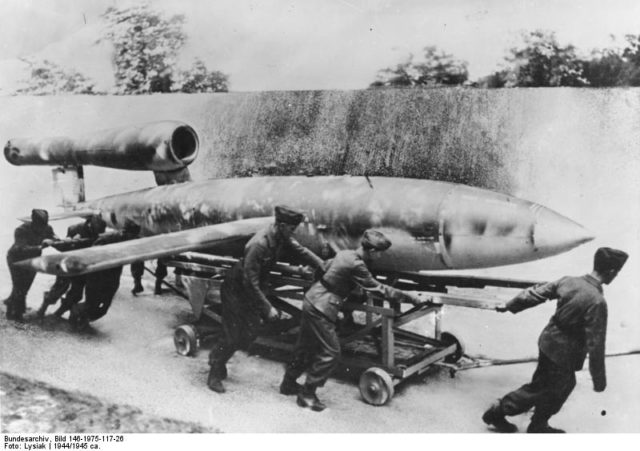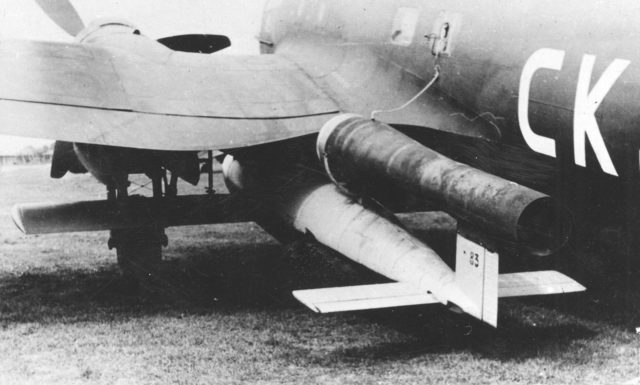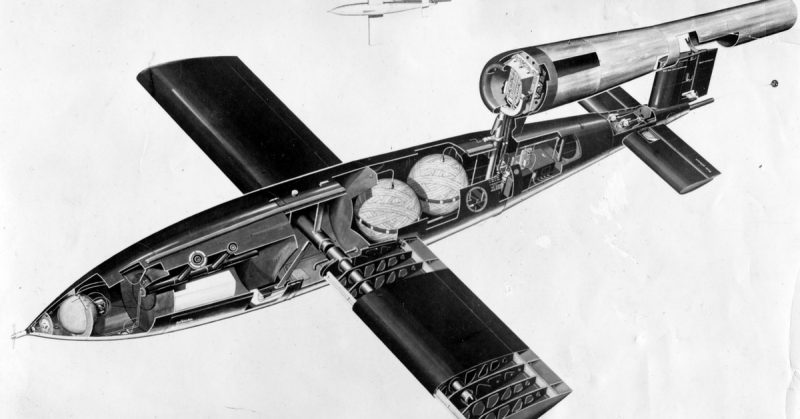Quickfire: 20 facts about the V1 Buzzbomb – here we go!
1) The V1 stands for Vergeltungswaffe-1, German for retaliatory weapons and they were developed to strike back at Britain in retaliation for the bombing of German cities.
2) Eventually, there were three V-weapons developed, the V2 was the first ballistic missile, the V3 was a super gun which was never finished.
3) The first V-1 was launched at London on 13 June 1944, one week after the invasion of France. It’s first flight, launched from a bomber, took place on December 10th 1942.
4) It was powered by a simple pulse jet engine which pulsed 50 times per second which gave it a characteristic buzzing sound causing it to be named “buzz bomb” or “doodlebug” by the British.
5) This is how a V1 sounded:
6) The V1 was guided by a simple autopilot that regulated airspeed and altitude, a weighted pendulum system was used to control pitch.
7) To determine the flight time an odometer, that was driven by a vane on the nose, calculated when the approximate target area had been reached. Before the launch of the V1, the counter was set to a value that would reach zero when it arrived at the target area in the prevailing wind conditions.
8) The V1 was launched from a ramp which was pointed in the approximate direction when it left the ramp it would fly at about 150 mp/h.
9) In earlier versions when the V1 went into a dive towards the target the engine would cut out due to fuel starvation, this problem was fixed in a later version when the engine kept powering the V1 all the way down.
10) To defend London against the V1s, anti-aircraft guns were redeployed in massive numbers on the approach routes of the rockets.

11) On the first night of sustained bombardment, the anti-aircraft crews around Croydon were jubilant – suddenly they were downing unprecedented numbers of German bombers; most of their targets burst into flames and fell when their engines cut out. There was a great disappointment when the truth was announced.
12) It proved very difficult to shoot down these small and fast unmanned planes. On top of that, they were designed to fly just above the effective range of light anti-aircraft guns, and just below the optimum height of the heavier anti-aircraft guns.
13) Proximity fuses and gun laying radar were used against the V1s with ever increasing success.
14) In their first week, 17% of all flying bombs that entered the coastal “gun belt” were destroyed by anti-aircraft guns. This increased to 60 percent by 23 August and 74 percent in the last week of august, when on one day 82 percent of all incoming V1s were shot down. The rate improved from one V-1 destroyed for every 2,500 shells fired, to one for every 100.
15) Hawker Tempest fighters were employed to counter this threat as they were fast enough and able to fly low enough (controlled) to keep up with the V1s, which flew at over 340 MPH.

16) One of the tactics used by the fighter pilots was to use the airflow over a fighter’s wing to raise one wing of the V-1. To achieve this, they had to slide the wingtip of the fighter plane to within 6 inches of the lower surface of the V-1’s wing. If properly executed, this maneuver would tip the V-1’s wing up, which would override the gyros and that would send the V-1 into an out-of-control dive. At least 16 V1s were destroyed this way.
17) To adjust and correct settings in the V-1 guidance system, the Germans needed to know where the V-1s were landing. Thus, German intelligence services were requested to obtain this data from their agents in Britain. However, all German agents in Britain had been captured and turned and were acting as double agents under British control giving inaccurate reports to the Germans.
18) A certain number of the V-1s fired had been fitted with radio transmitters, which had clearly demonstrated a tendency for the V-1 to fall short of the intended target. The commander of the V1 campaign compared the data gathered by the transmitters with the reports obtained through the double agents. He concluded that the discrepancy between the two sets of data must be caused by a fault with the radio transmitters, as he had been assured that the agents were completely reliable.
19) By September 1944, the launch sites on the French coast were overrun by the advancing Allied armies and the V-1 threat to England was temporarily halted. A total of 4,261 V-1s had been destroyed by fighters, anti-aircraft fire and barrage balloons.
20) On the 29th of March 1945, a V-1 struck Datchworth in Hertfordshire which was the last enemy action of any kind on British soil.
https://www.youtube.com/watch?v=Q1qsBGTkVSk
